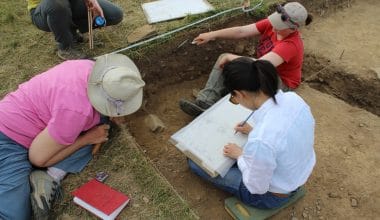Mastering the art of stacking firewood is not just about neatness—it’s a crucial skill for efficient storage and optimal seasoning. In this article, we’ll delve into the essential steps and techniques to stack a cord of wood like a seasoned pro, ensuring your firewood stays dry, well-ventilated, and ready to fuel cozy nights by the fireplace.”
Table of contents
- How to Stack A Cord of Wood
- #1. Selecting the Right Location:
- #2. Gathering Supplies:
- #3. Measuring and Organizing:
- #4. Sorting Wood:
- #5. Creating a Stable Base:
- #6. Building Upward:
- #7. Maintaining Uniformity:
- #8. Avoiding Gaps:
- #9. Covering the Top:
- #10. Monitoring Moisture Levels:
- #11. Organizing for Accessibility:
- #12. Safety Measures:
- What Should You Consider When Selecting a Location to Stack A Cord of Wood
- Frequently Asked Questions
- Conclusion
- References
- Recommendations
How to Stack A Cord of Wood
Stacking a cord of wood efficiently is not only a practical skill but also crucial for maintaining the quality and usability of the firewood. Here’s an in-depth guide on how to stack a cord of wood:
#1. Selecting the Right Location:
● Choose a well-drained area to prevent moisture absorption.
● Keep the woodpile away from structures to avoid insect infestation.
#2. Gathering Supplies:
● Use a solid base like pallets or a layer of logs to elevate the woodpile.
● Gather essential tools: gloves, a tape measure, and, if necessary, a wheelbarrow.
#3. Measuring and Organizing:
● A standard cord of wood is 4 feet high, 4 feet wide, and 8 feet long.
● Begin by measuring and marking these dimensions to guide your stacking.
#4. Sorting Wood:
● Separate different types of wood to ensure proper seasoning and burning characteristics.
● Stack larger, heavier logs at the bottom for stability.
#5. Creating a Stable Base:
● Lay the first layer of logs parallel to each other.
● Stagger the logs for stability and optimal weight distribution.
#6. Building Upward:
● As you stack, aim for a crisscross pattern to promote air circulation.
● Interlock the logs to prevent the woodpile from collapsing.
#7. Maintaining Uniformity:
● Keep the stack level and straight to prevent leaning or instability.
● Align the ends of the logs for a neat appearance.
#8. Avoiding Gaps:
● Minimize gaps between logs to reduce the risk of pests and moisture.
● Fill spaces with smaller pieces to create a compact, solid structure.
#9. Covering the Top:
● Place a tarp or cover on the top of the woodpile to shield it from rain and snow.
● Ensure the cover extends slightly beyond the edges for complete protection.
#10. Monitoring Moisture Levels:
● Regularly check the woodpile for signs of mold or excessive moisture.
● Rotate the logs if needed to promote even drying.
#11. Organizing for Accessibility:
● Place the woodpile in a location that allows easy access for transporting wood to your living space.
● Consider creating paths between rows for accessibility.
#12. Safety Measures:
● Stack wood away from areas with high fire risk.
● Be cautious of uneven ground to prevent tripping or collapsing woodpiles.
By following these detailed steps, you’ll create an aesthetically pleasing woodpile and ensure your firewood remains dry, well-ventilated, and ready to provide warmth during the colder months.
What Should You Consider When Selecting a Location to Stack A Cord of Wood
Choosing the appropriate location for stacking a cord of wood is a foundational step that significantly impacts the quality and longevity of the firewood. Here’s an in-depth exploration of the critical considerations and their implications:
#1. Drainage and Moisture Control:
● Opt for a well-drained area to prevent water accumulation around the woodpile.
● Moisture is the nemesis of firewood, as it can lead to mold, decay, and difficulties in burning.
● Elevate the woodpile using pallets or a layer of logs to create a barrier against ground moisture.
#2. Distance from Structures:
● Position the woodpile at a safe distance from buildings and other structures.
● Placing it too close can invite insects and pests, potentially causing damage to the wood.
● A recommended distance is at least 20 feet from structures to mitigate these risks.
#3. Sunlight Exposure:
● While a shaded area may protect wood from excessive drying, striking a balance is crucial.
● Some exposure to sunlight aids in the natural seasoning process by facilitating evaporation of internal moisture.
● Avoid densely shaded areas that hinder proper drying and promote a damp environment.
#4. Air Circulation:
● Good air circulation is essential for the seasoning of firewood.
● Choose a location that allows for natural airflow through the stack.
● Adequate ventilation minimizes the chances of mold growth and ensures even drying.
#5. Topography and Slope:
● Select a flat and level area to prevent the woodpile from leaning or collapsing.
● Uneven ground can pose safety hazards during stacking and may result in an unstable woodpile.
#6. Accessibility:
● Consider the convenience of access when choosing the location.
● If the woodpile is too far from your living space, it may be impractical to transport wood regularly.
● Create paths between rows for easy access and movement.
#7. Protection from Wind:
● While good ventilation is crucial, excessive wind can accelerate drying and lead to overseasoned, brittle wood.
● If the location is prone to strong winds, consider natural windbreaks or erecting a barrier to moderate wind exposure.
#8. Fire Risk:
● Place the woodpile away from areas with high fire risk, such as dry grass or dense vegetation.
● Exercise caution to prevent accidental fires, especially in regions susceptible to wildfires.
Frequently Asked Questions
Elevating prevents ground moisture absorption, preserving firewood quality.
Use a tarp or cover, ensuring it extends beyond the edges for complete protection.
Staggering improves stability and minimizes the risk of the woodpile collapsing.
Prevents insect infestation and maintains the integrity of the firewood.
Group similar wood types, considering density and combustion characteristics.
Conclusion
Mastering the art of stacking a cord of wood involves strategic decisions—from selecting the right location to sorting wood types. By considering factors like drainage, sunlight exposure, and proper stacking techniques, you ensure a well-ventilated, accessible, and visually appealing woodpile. These practices enhance the longevity and quality of firewood and contribute to a seamless and cozy experience by the fireplace.
References
- youtube.com: How to stack a cord of wood.
- theartofdoingstuff.com; How to stack wood.





